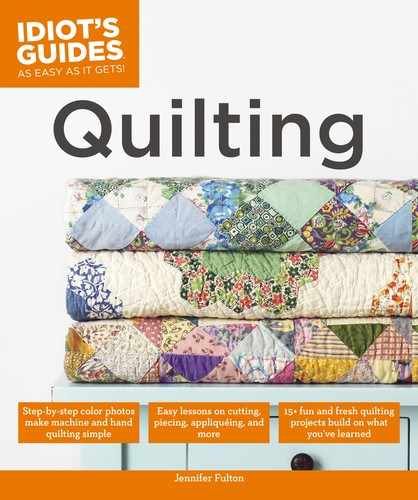
176
CHAPTER PREPARING A QUILT FOR QUILTING
If you plan to do your own quilting, take time to choose a quilt pattern that complements your quilt
project and suits your skill level. Quilting patterns can be found in quilting books and magazines, as
well as through online sources.
As you consider quilting designs, keep two things in mind: first, the batting you choose dictates how
close your quilting must be. If your batting requires quilting no less than 4 inches apart, don’t select a
quilting pattern with quilting lines 6 inches apart. Second, remember that the quilting must be evenly
distributed over the quilt top in order for your quilt to lay flat.
Plan Your Quilting
PRACTICE PROJECT
Consider Your Quilt
The quilting pattern you choose should complement
the design of your quilt and fabric choices. Curvy
quilting complements quilts with lots of straight lines,
and vice versa. Traditional fabrics are complemented
by traditional quilting designs, and vice versa. Decide
whether you want to use an overall pattern, which
covers the whole quilt, or different designs for differ-
ent areas, such as the blocks, sashing, and borders. An
overall pattern is best if your quilt is visually complex
(lots of piecing or busy fabrics), while custom quilting
is the perfect choice for areas with simple piecing and
solid or tone-on-tone fabrics.

177
PRACTICE PROJECT PLAN YOUR QUILTING
Consider Straight Line Quilting
Straight line quilting is the easiest type of quilting to
master because straight lines are easy to follow. You
can quilt straight lines up and down, diagonally, or in
a grid across your quilt. Mark the lines using painter’s
tape, and quilt on one or both sides of the tape. You
can skip the marking process and eyeball a straight
line or so curve from one point of a block to another.
You can also outline quilt
1
⁄
4
inch away from the seams
in a block without marking, by using the edge of the
presser foot as a guide. Although it might seem easy
to quilt between the two sides of a seam (stitch in the
ditch), it’s actually somewhat difficult, and not recom-
mended for beginners.
Consider Free-Motion Quilting
Free-motion quilting allows you to quilt in any direc-
tion, creating interesting shapes and designs. Free-
motion quilting can be challenging because it requires
you to manually move the quilt under the needle, in
tempo with the speed of the machine. Stippling and
meandering are good designs for a first-time free-
motion project because there’s no pattern you have to
try to follow and you can move the quilt in whatever
direction you like. Echo quilting repeats the curves
of applique shapes and is also easy, because you can
use the edge of presser foot as a guide as you stitch
around each appliqué.
Test Quilting Designs
For more complex free-motion designs, you’ll need to
follow a pattern. Try out different designs by marking
them on upholstery vinyl or cellophane using a dry-
erase marker. Look at the quilts in this book, in maga-
zines, and in local quilt stores for quilting ideas. When
you’ve found one you like, copy it to Golden Threads
quilting paper, Quilt & Tear, vellum tracing paper, or
tissue paper. Pin the paper to your quilt and quilt by
simply following the lines. The paper should remove
easily aer quilting.
Meandering

..................Content has been hidden....................
You can't read the all page of ebook, please click here login for view all page.
